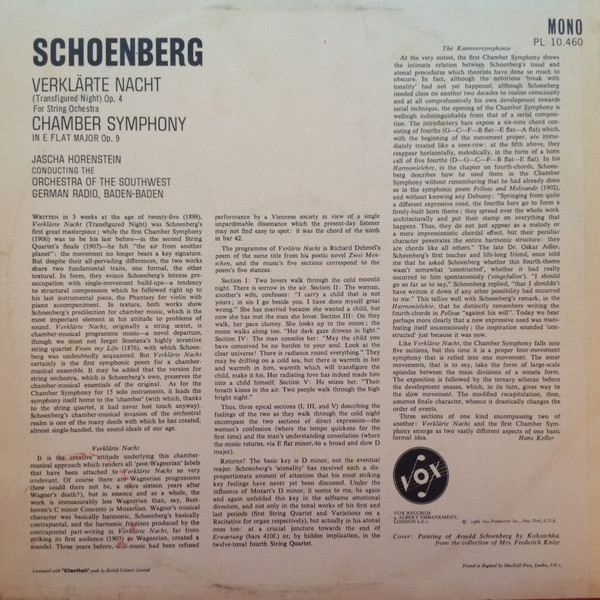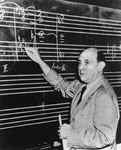Schoenberg - Verklärte Nacht Op4 Chamber Symphony Op9
Table of Contents
Download
Filename: schoenberg-verklrte-nacht-op4-chamber-symphony-op9.zip- MP3 size: 8.2 mb
- FLAC size: 108 mb
Tracks
| Track | Duration | Preview |
|---|---|---|
| Verklärte Nacht Opus 4 (Transfigured Night) For String Orchestra | ||
| Chamber Symphony In E Flat Major, Opus 9 |
Video
Schoenberg: Verklaerte Nacht op.4, SWDR/Horenstein
Schoenberg: Chamber Symphony no.1 (SWDR/Horenstein)
Images




Catalog Numbers
PL 10.460Labels
VOXListen online
- ascolta in linea
- kuunnella verkossa
- online anhören
- online luisteren
- ouvir online
- écouter en ligne
- lytte på nettet
- escuchar en línea
- lyssna på nätet
Formats
- Vinyl
- LP
- Mono
Companies
| Role | Company |
|---|---|
| Copyright (c) | Vox Productions, Inc. |
| Printed By | MacNeill Press Ltd. |
Credits
| Role | Credit |
|---|---|
| Conductor | Jascha Horenstein |
| Orchestra | Südwestfunkorchester Baden-Baden (tracks: Orchestra Of The Southwest German Radio) |
| Painting | Oskar Kokoschka (tracks: Kokoschka) |
| Sleeve Notes | Hans Keller |
Notes
- Label - Black with silver print, 'Made in England'
- Sleeve - 'Printed In England'
Barcodes
- Matrix / Runout (side-1 stamped): PL-10.460.A-1B
- Matrix / Runout (side-2 stamped): PL-10.460.B-1B
About Schoenberg






Austrian composer and painter, best known as the (putative) innovator of the twelve-tone technique. Leader of the Second Viennese School.
Starting from the exasperated Wagnerian chromatism of the Tristan with the sextet for strings "Verklärte Nacht" Op. 4 of 1899, the symphonic poem "Pelleas und Melisande" Op.5 of 1903 and the cantata "Die Gurrelieder"( 1900-1911), he reached the total decomposition and liquidation of the Tonality and Harmony with the "Three Pieces for Piano" Op 11 of 1909, "Five Pieces for Orchestra" Op 16 (1909) and the "Pierrot Lunaire" (1912).
With the Five Pieces for Piano Op. 23 and the Serenade Op 24 of 1923 Schoenberg organizes the sounds in a rational way, which he defined:
"Method of Composition by means of twelve tones in relation only to each other " called Dodecaphony or" serial music ".
Born 13 September 1874 in Vienna, Austria as Arnold Schönberg, emigrated to the US in 1933 and changed his name to Arnold Schoenberg. He died 13 July 1951 in Los Angeles, California, USA.
Real Name
- Arnold Schönberg
Name Vars
- A. Schoenberg
- A. Schonberg
- A. Schöenberg
- A. Schönberg
- A. Šenberg / A. Schoenberg
- A.Schoenberg
- A.Schönberg
- Arnold Schoemberg
- Arnold Schoenberg (1874 - 1951)
- Arnold Schonberg
- Arnold Schöenberg
- Arnold Schönberg
- Arnold Schœnberg
- Arnold Šenberg
- Schoenberg
- Schoenberg, Arnold
- Schonberg
- Schönberg
- Schöenberg
- Schönberg
- Schœnberg
- А. Шeнберг
- А. Шенберг
- А. Шёнберг
- А.Шёнберг
- Арнолд Шенберг
- Арнолд Шьонберг
- Арнольд Шенберг
- ¢ëÎëÈû·§üóÙë¯
- ·§üóÙ¯
- ·§üóÙë¯
Comments
2023-04-13
Verklaerte was my first introduction to this great conductor years ago on a VOX vinyl recording. After close to 50 years of listening to and collecting this work on CDs and vinyl, it is still my first choice. The passion of the poem that inspired this masterpiece is fully revealed like no other recording, in my opinion! Thank you so much for posting it!
2023-04-13
siempre,por siempre
2023-04-12
what a wall of sound in the climaxes !⚡️?⚡️
2023-04-12
nearly so good as the famous Karajan BPO recording. Sounds great and urgent.
2023-04-11
HORENSTEIN is my favorite conductor!
2023-04-11
Leaves behind most other recordings in intensity, phrazing and sound color. Even Stokowski can not hold a candle to Horenstein, and Stokowski was one of music's greatest sound wizards ever...
2023-04-10
Favourite. Most of the other versions have the audio level too soft.
2023-04-09
Gorgeous interpretation!
2023-04-09
Horenstein really brings out the romanticism in this work. I have heard so many performances of this piece that are rushed, and therefore sound superficial. Horenstein maintains the momentum, but ensures that we never miss the points of detail. Best ever interpretation.
